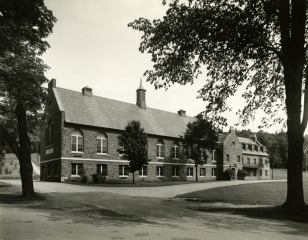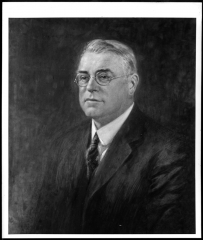Sponsored by the chapter, the Phi Society elected annually those sophomores whose first year’s work merited recognition for excellence. Nine members of the Class of 1931 became its initial members in December 1928.
Since the A.B., B.S., and B.Th. degrees were nearly equivalent the faculty in 1926 decided upon one degree, the A.B., with uniform requirements; the B.D. was retained for theological students who had taken two extra years. With the increasing emphasis on the undergraduate work the faculty came to recognize that the college was not prepared to maintain programs for the master’s degrees in arts and science, which had never attracted many students, and in 1926 gradually began to eliminate them; ten years later they had disappeared.
Enrollment in the College in the Cutten period showed a steady gain, save a slight decrease in the Depression years 1932-35, with the total rising from 664 in 1922 to a high of 1,092 in 1939 and declining to 1007 in 1942. Seminary enrollment stayed at about 60 until the removal to Rochester in 1928. It was in the fall of 1930, however, that the enrollment reached the 1,000 mark. Though the totals after 1930 frequently went beyond the 1,000 limit set by the Trustees in 1924 the excess was slight and attrition through the academic year was sufficient to prevent serious overcrowding of facilities.
As was to be expected, student life reflected the spirit and behavior on eastern campuses in the carefree “roaring twenties” and Depression ’30’s. Colgate was noted for its athletic enthusiasm which often overshadowed its genuine non-athletic accomplishment. Mobility became increasingly easier with the greater number of student automobiles. In 1923 it became necessary to restrict owning and operating motor vehicles to juniors and seniors and to require that vehicles be registered at the Registrar’s Office. By 1928 parking had become so much of a problem that the Trustees adopted a set of rules to deal with it. Student dress of the 20’s featured coonskin coats for the more affluent, and sheepskin-lined khaki coats with high collars for their fellows. Red rubber overshoes and maroon sweaters were worn in winter, and distinctive class blazers in the fall and spring. The Class of 1926 seems to have been the first to adopt the blazer which remained in vogue until 1931. Perhaps white bucks were the hallmark of the less flamboyant ’30’s.
Student discipline, long the province of the Senior Governing Board which concerned itself about such matters as enforcing the wearing of







